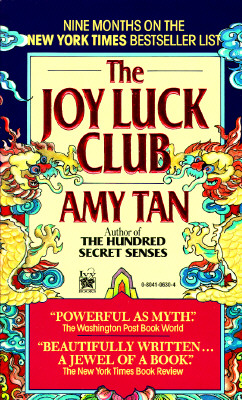

She is nearly prostrate with grief when her husband, Ted, demands a divorce. Like Jing-mei Woo, An-mei's daughter Rose is unsure of herself. After her mother's suicide, An-mei came to America, married, and had seven children. She was without status because her mother was only the third wife. She lacks her mother's drive and self-confidence but finds her identity after her mother's death when she meets her twin half-sisters in China.Īn-mei Hsu grew up in the home of the wealthy merchant Wu Tsing.

Her American-born daughter, Jing-mei "June" Woo, works as a copywriter for a small advertising firm. Suyuan Woo, the founder of the Joy Luck Club, barely escaped war-torn China with her life and was forced to leave her twin infant daughters behind. Through their stories, Jing-mei comes to appreciate the richness of her heritage. As its members play mah jong and feast on Chinese delicacies, the older women spin stories about the past and lament the barriers that exist between their daughters and themselves. The novel focuses on Jing-mei "June" Woo, a thirty-six-year-old daughter, who, after her mother's death, takes her place at the meetings of a social group called the Joy Luck Club. The Joy Luck Club describes the lives of four Asian women who fled China in the 1940s and their four very Americanized daughters. The fact remains, however, that more Asian-Americans are writing, and their books have a fresh and original voice. In part, this interest in Asian-American literature can be attributed to the near doubling of America's Asian-American population, from 3.5 million to 6.9 million in the past ten years.

Perhaps not since the literary community "discovered" Jewish-American writers in the 1950s have we experienced such a concentrated ethnic wave. Gish Jen's Typical American is an equally big hit.Īt the same time, Japanese-American writers are flourishing. Two publishers fought for the right to publish David Wong Louie's Pang of Love, a collection of short stories. The Literary Guild purchased the rights to the book Random House did an audio version with M. Gus Lee's China Boy, for example, had an initial print run of 75,000, huge for a first-time author. Two years later, at least four other Chinese-American writers had brisk-selling books. The success of Tan's book increased publishers' willingness to gamble on first books by Asian-American writers. The Joy Luck Club, Amy Tan's first novel, sold an astonishing 275,000 hard-cover copies upon its 1989 publication. Even so, ten more years had to pass until another Asian-American writer achieved fame and fortune. It was not until the 1976 publication of Maxine Hong Kingston's mystical memoir of her San Francisco childhood, The Woman Warrior, that Asian-American writers broke into mainstream American literature.


 0 kommentar(er)
0 kommentar(er)
